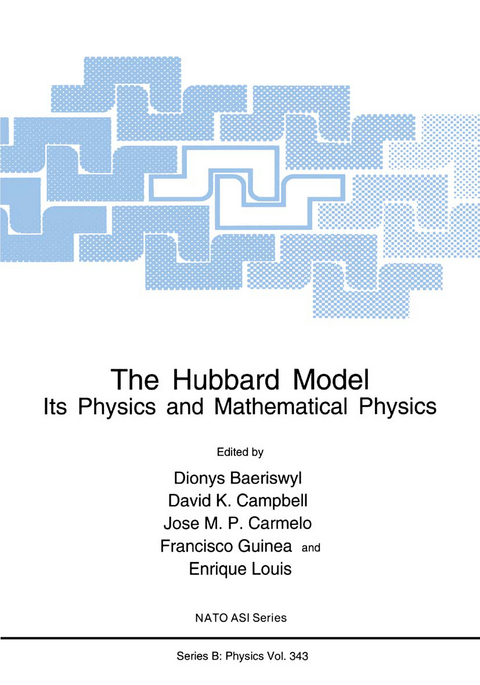
The Hubbard Model
Springer-Verlag New York Inc.
978-1-4899-1044-8 (ISBN)
Solvable Models, Rigorous Results, and Advances in Formalism.- The Hubbard Model: Some Rigorous Results and Open Problems.- On the Bethe Ansatz Soluble Degenerate Hubbard Model.- Thermodynamical Properties of the Exactly Solvable 1/r-Hubbard and 1/r-tJ Model.- Hierarchy of 1-D Electron Models with Long-Range Interaction.- One-Dimensional Luttinger Liquid of Particles for a Class of Infinitely Repulsive Interactions: Exact Solutions.- Exact Results for Spin and Charge Dynamics of Electrons with Supersymmetry.- Hidden Symmetry of Strongly Correlated Fermions.- Symmetries of Strongly Correlated Electrons.- Exact Results on a Supersymmetric Extended Hubbard Model.- Functional Integrals for Correlated Electrons.- Charge-Spin Separation and Pairing in a Generalized Hubbard Model.- A Renormalization Procedure for the Hubbard Model.- New Operator Algebra for the Hubbard Chain.- Exact Results and Conjectures on the Adiabatic Holstein-Hubbard Model at Large Electron-Phonon Coupling.- Ferromagnetism in Correlated Electron Systems: A New Class of Rigorous Criteria.- Infinite in All Directions: Large Coupling, High Dimensions, and Many Components.- The Mott Transition in Infinite Dimensions: Old Ideas and Some Surprises.- The Hubbard Model with Local Disorder in d = Infinity.- The Hubbard Model with Infinite Interaction: Magnetic Properties.- The Extended Hubbard Model at Large Interaction.- Drude Weight and f-Sum Rule of the Hubbard Model at Strong Coupling.- The Gutzwiller Projector in the Large U-Hubbard Model.- Revising the 1/N Expansion for the Slave-Boson Approach within the Functional Integral.- Fermi Liquid versus Luttinger Liquid.- “Infarared Catastrophe:” When Does It Trash Fermi Liquid Theory?.- Two-Particle Scattering and Orthogonality Catastrophe in the HubbardModel.- Failure of Fermi Liquid Theory in 2-Dimensions: How to Infer it from Peturbation Theory.- Conservation Laws in Normal Metals: Luttinger Liquid vs. Fermi Liquid.- Charge-Spin Separation and the Spectral Properties of Luttinger Liquids.- Non-Fermi Behavior in the Kondo and Heisenberg Models.- Luttinger-Liquid Behavior in 2-D: The Variational Approach.- Non-Fermi Liquid Behavior of Electrons in the 2-D Honeycomb Lattice: A Renormalization Group Analysis.- Search for Deviations from Fermi Liquid Behavior in 2-D Repulsive and Attractive Hubbard Models.- Perturbative, Mean Field, Variational, and Numerical Studies.- Hartree-Fock and RPA Studies of the Hubbard Model.- From One- to Two-Dimensions in the Weak Coupling Limit.- Metal-Insulator Transition in the 2-D Hubbard Model: A Fermionic Linearization Approach.- The Phase Diagram of the One-Dimensional Extended Hubbard Model.- Quantum-Monte-Carlo Simulations of Correlation Functions for the One-Dimensional Hubbard Model.- Quantum-Monte-Carlo Studies of One- and Two-Dimensional Hubbard Models.- Effect of Disorder on Several Properties of the One-Band Hubbard Model in 2-D.- The Wavefunction Renormalization Constant for the One- and Two-Band Hubbard Hamiltonians in Two-Dimensions.- Experiments and Physical Applications.- Electron Spectroscopy and Hubbard: Issues and Opportunities.- On Electrical Properties of Chalcogenide Glassy Semiconductors in the Framework of Hubbard Model with Negative Correlation Energy.- The Metal Insulator Transition in the Hubbard Model.- Metal to Insulator Transition in the 2-D Hubbard Model: A Slave-Boson Approach.- The Hubbard Model and Its Application to Conjugated ?-Electron Systems.
| Reihe/Serie | NATO Science Series: B ; 343 |
|---|---|
| Zusatzinfo | XII, 407 p. |
| Verlagsort | New York |
| Sprache | englisch |
| Maße | 178 x 254 mm |
| Themenwelt | Naturwissenschaften ► Physik / Astronomie ► Atom- / Kern- / Molekularphysik |
| ISBN-10 | 1-4899-1044-1 / 1489910441 |
| ISBN-13 | 978-1-4899-1044-8 / 9781489910448 |
| Zustand | Neuware |
| Haben Sie eine Frage zum Produkt? |
aus dem Bereich


